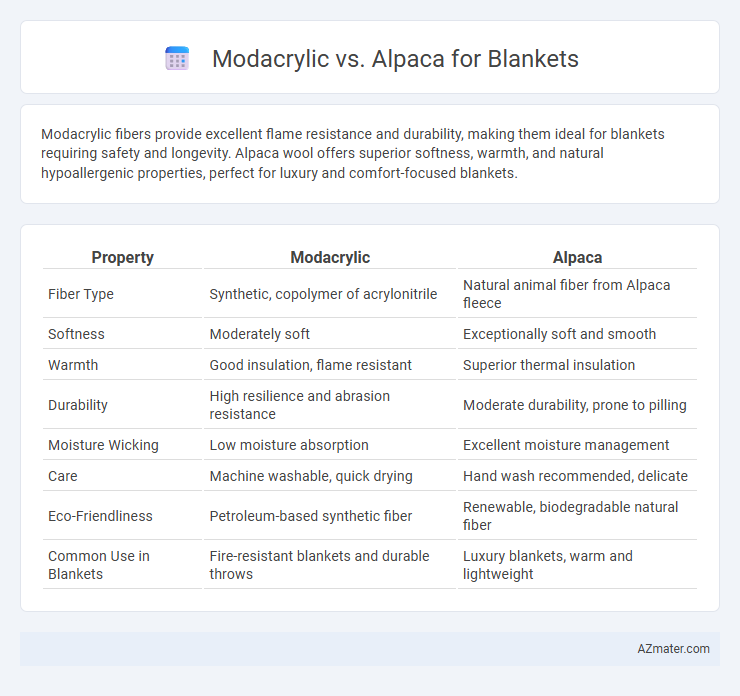Modacrylic fibers provide excellent flame resistance and durability, making them ideal for blankets requiring safety and longevity. Alpaca wool offers superior softness, warmth, and natural hypoallergenic properties, perfect for luxury and comfort-focused blankets.
Table of Comparison
| Property | Modacrylic | Alpaca |
|---|---|---|
| Fiber Type | Synthetic, copolymer of acrylonitrile | Natural animal fiber from Alpaca fleece |
| Softness | Moderately soft | Exceptionally soft and smooth |
| Warmth | Good insulation, flame resistant | Superior thermal insulation |
| Durability | High resilience and abrasion resistance | Moderate durability, prone to pilling |
| Moisture Wicking | Low moisture absorption | Excellent moisture management |
| Care | Machine washable, quick drying | Hand wash recommended, delicate |
| Eco-Friendliness | Petroleum-based synthetic fiber | Renewable, biodegradable natural fiber |
| Common Use in Blankets | Fire-resistant blankets and durable throws | Luxury blankets, warm and lightweight |
Introduction to Modacrylic and Alpaca Blankets
Modacrylic blankets are crafted from synthetic fibers known for their durability, wrinkle resistance, and vibrant color retention, making them a practical choice for everyday use. Alpaca blankets, made from the natural fleece of the alpaca, offer exceptional softness, warmth, and hypoallergenic properties, prized for luxury and comfort in colder climates. Both materials serve distinct purposes, with modacrylic excelling in affordability and ease of care, while alpaca provides superior insulation and a premium tactile experience.
Fiber Origins: Synthetic vs Natural
Modacrylic fibers, derived from synthetic polymers, offer excellent durability, flame resistance, and colorfastness ideal for blankets requiring low maintenance and high resilience. Alpaca fibers, harvested from the natural fleece of South American alpacas, provide superior softness, warmth, and hypoallergenic properties, making them a luxurious choice for natural fiber blankets. The key difference lies in originating from petrochemical processes for modacrylics versus animal-sourced natural protein fibers for alpacas, impacting texture, care, and environmental footprint.
Warmth and Insulation Comparison
Modacrylic fiber offers synthetic warmth and excellent insulation due to its resistance to moisture and ability to retain heat, making it suitable for cold environments. Alpaca wool provides natural warmth with superior thermal regulation, trapping heat while allowing breathability, which prevents overheating. Comparing their insulation, alpaca blankets generally outperform modacrylic in maintaining warmth through natural fiber properties, while modacrylic is favored for durability and moisture resistance.
Softness and Comfort Analysis
Modacrylic fibers offer a soft texture with high durability and resistance to wrinkles, making blankets made from this synthetic material comfortable and long-lasting. Alpaca wool provides exceptional softness, warmth, and natural hypoallergenic properties due to its fine, silky fibers, enhancing comfort in blankets. While alpaca excels in thermal insulation and luxurious softness, modacrylic delivers easier care and hypoallergenic benefits suitable for sensitive skin.
Durability and Longevity
Modacrylic blankets offer superior durability due to their synthetic fiber composition, making them resistant to wear, shrinkage, and fading over time. Alpaca blankets, crafted from natural alpaca fiber, provide long-lasting softness and warmth but require delicate care to maintain their integrity and prevent pilling. In terms of longevity, modacrylic blankets typically withstand frequent washing and heavy use better than alpaca, which excels in comfort and thermal insulation but may show signs of aging sooner without proper maintenance.
Allergen and Sensitivity Considerations
Modacrylic fibers are hypoallergenic and resistant to mold and mildew, making them suitable for individuals with sensitive skin or allergies. Alpaca wool, while naturally soft and thermoregulating, can sometimes cause irritation in people with wool sensitivities due to lanolin content. Choosing modacrylic blankets reduces the risk of allergic reactions, whereas alpaca blankets require caution for those prone to fiber-related sensitivities.
Care and Maintenance Requirements
Modacrylic blankets require low maintenance, as they are machine washable, wrinkle-resistant, and quick-drying, making them ideal for easy care. Alpaca blankets need more delicate handling, typically requiring hand washing or dry cleaning to preserve natural fibers and softness, preventing shrinkage or fiber damage. Proper storage for Alpaca blankets includes avoiding humidity and moth exposure to maintain longevity and texture.
Sustainability and Environmental Impact
Modacrylic blankets offer durability and resistance to moisture but rely on synthetic fibers derived from petrochemicals, contributing to non-biodegradability and higher carbon footprints. Alpaca blankets, made from natural animal fibers, provide biodegradable, renewable, and eco-friendly options with lower environmental impact due to sustainable alpaca farming that promotes soil health and biodiversity. Choosing alpaca blankets supports sustainable textile production and reduces reliance on fossil fuels compared to modacrylic alternatives.
Cost and Availability
Modacrylic blankets typically offer a more budget-friendly option compared to alpaca blankets, which are often priced higher due to the rarity and luxury status of alpaca fiber. Modacrylic fibers are synthetic and widely available, making blankets made from this material easier to find in various retail outlets globally. Alpaca blankets, sourced from the Andes, have limited availability outside specialized boutiques and tend to have a longer production cycle, impacting both cost and market presence.
Choosing the Right Blanket: Modacrylic or Alpaca?
Modacrylic blankets offer durability, easy maintenance, and affordability, making them ideal for allergy sufferers and households seeking low-maintenance warmth. Alpaca blankets provide superior softness, natural thermal regulation, and hypoallergenic properties, perfect for those desiring luxury and eco-friendly insulation. Choosing between modacrylic and alpaca depends on prioritizing budget, care convenience, and natural fiber benefits for optimal comfort.

Infographic: Modacrylic vs Alpaca for Blanket
 azmater.com
azmater.com